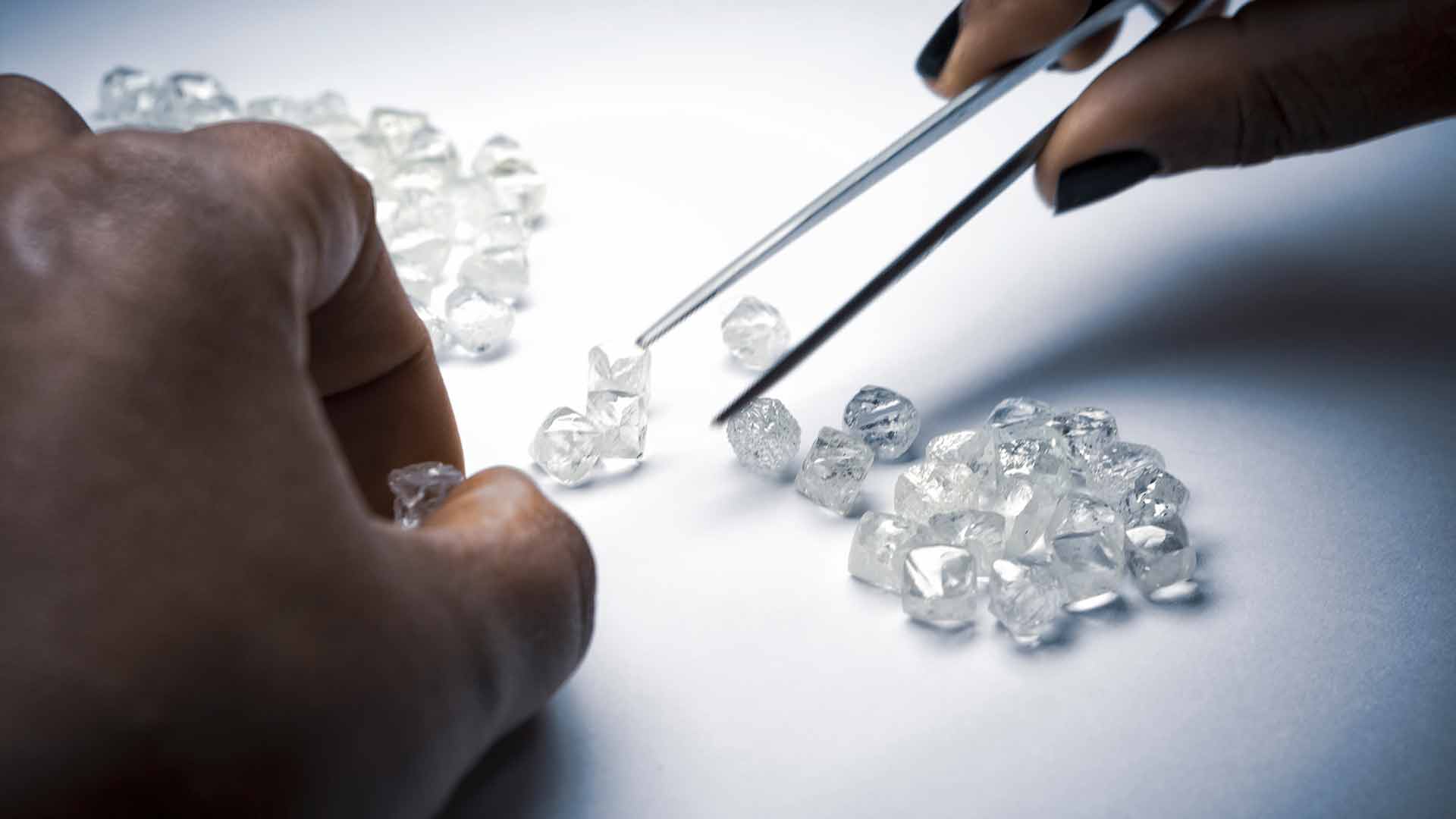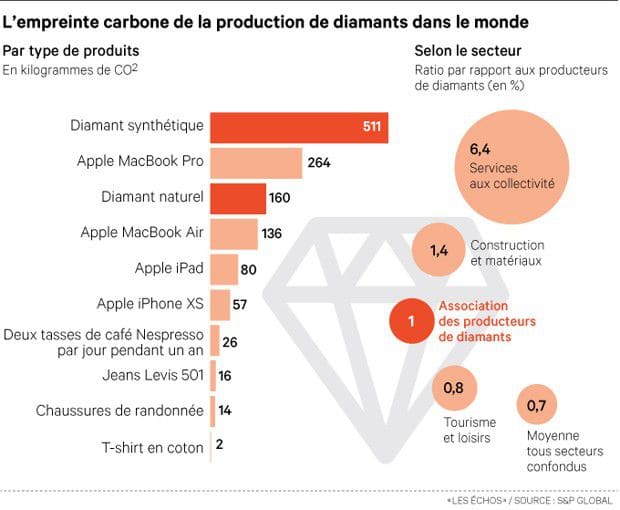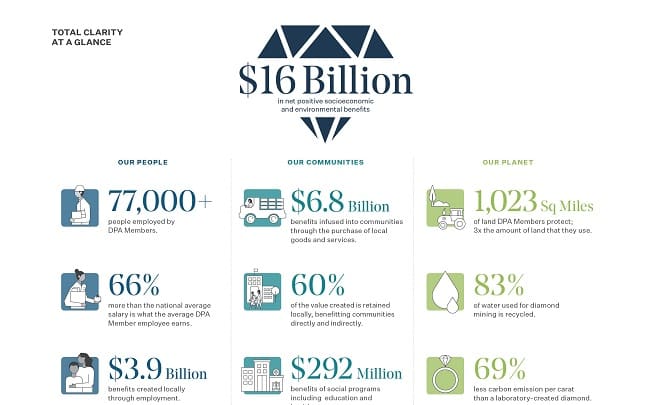Ethical diamond

In recent months, the diamond industry has experienced a seismic shift. While a natural diamond took 1 to 3.3 billion years (between 25 and 75% the age of the Earth) to crystallize its carbon atoms deep within the Earth, a synthetic diamond can now be grown in a state-of-the-art laboratory in a matter of weeks. These synthetic diamonds are becoming fashionable in the wave of "conscious luxury" and are increasingly associated with the term "ethical diamond". The appeal of lab-grown diamonds is expected to be particularly strong among the Millennial generation, for whom ethics and the environment are major considerations. They are also widely perceived as less materialistic than previous generations, less attached to traditional romantic notions of natural stones and attracted to the modernity of the laboratory process.
Is the synthetic diamond really a more ethical and "greener" diamond than the natural one?
There has been a debate in recent months about whether natural diamond mining companies are more environmentally friendly or more harmful than companies producing lab-grown diamonds that claim in their advertising to have the most environmentally friendly stone.
Surfing on the green conscience, a trend cherished by Millennials, lab-grown diamonds are often referred to as "green" diamonds, with no ecological cost. However, the high technology used to develop them requires a significant amount of energy. While some manufacturers are beginning to use renewable energy, particularly in California, in India and China, fossil fuels take precedence.
Although the ethical promise gives synthetic stones an air of moral superiority, it is nonetheless difficult to justify, especially in such a young sector that is not yet subject to rigorous ethical control. It is difficult to know what checks have been made on working conditions and environmental standards in factories in China or India, for example. A considerable amount of energy is required for the production process of synthetic stones and the facilities may not have access to renewable energy.
The Federal Trade Commission (FTC), the U.S. competition authority, recently warned several synthetic diamond producers against misusing claims such as "environmentally friendly" or "sustainable" without qualification.

Natural diamond production uses less than a third of the energy required to create a synthetic diamond in the laboratory
The Diamond Producers Association (DPA) has released a report on the environmental and social impact of the diamond mining industry that apparently refutes claims by lab-grown diamond companies that their product has less environmental impact than stones mined from the ground and is therefore more ethical.
The report, entitled "The Socio-Economic and Environmental Impact of Large-Scale Diamond Mining," was conducted by Trucost ESG Analysis, a subsidiary of S & P Global. It studied the members of the Diamond Producers Association, the major miners that make up 75% of the world's diamond production. The world's leading diamond producers are made up of seven companies - ALROSA, De Beers Group, Dominion Diamond Mines, Lucara Diamond Corp, Murowa Diamonds, Petra Diamonds and Rio Tinto - and employ over 77,000 people worldwide. DPA members operate diamond mines in the following countries: Botswana, Russia, Canada, Namibia, South Africa, Lesotho, Australia, Zimbabwe and Tanzania.
Libby Bernick, Managing Director and Global Head of Trucost Corporate Business at S & P Global, said her group was authorized to conduct an independent, two-year study that gathered a wealth of data.

The report's findings shatter outdated stereotypes and misconceptions: the operations of natural diamond producers' mining companies emitted an average of 160 kilograms of carbon dioxide (CO2) for every 1 carat of diamonds produced in 2016, compared to estimated greenhouse gas emissions of 511 kilograms of CO2 for every 1 carat of laboratory-grown diamonds. Greenhouse gas emissions - the strongest environmental impact - generated by the production of natural diamonds are therefore three times lower per carat than those associated with the manufacture of synthetic stones.
Bernick admitted that it was difficult to find reliable figures on the laboratory diamond sector. DPA CEO Jean-Marc Lieberherr said his group would be delighted if lab-grown diamond companies would share their impact data and publish sustainability reports. "The more transparency, the better," he said. "Right now, there is little information on their energy consumption and even less on their water consumption. To cool a reactor, the heat from the sun requires millions of gallons of water each year." While Trucost's numbers look good for the mining giants, Lieberherr admits that they may change. "When lab diamonds are produced with renewable energy, the situation can change," he said. "The reality today is that they are not." The International Cultivated Diamond Association did not respond to a request for comment from the press.
The Socio-Economic and Environmental Impact of Large-Scale Diamond Mining: Increasingly Ethical Practices
Despite significant progress in responsible and transparent practices over the past 15 years, the current reality of the diamond mining industry remains largely unknown. This Trucost report provides access to data and initiatives from an industry that is increasingly scrupulous and ethical, but still largely suffers from a poor reputation.
Trucost ESG Analysis finds that the world's major diamond producers are pumping billions of dollars in benefits into communities, offering wages above the national average and working to reduce environmental impact. Natural diamond producers emphasize the strict ethical regulations that govern their industry and the socio-economic benefits of diamond mining to communities and countries, including environmental initiatives such as wildlife preservation and restoration of mined land.
The Trucost report highlights the impact that mining groups collectively have on the communities in which they operate and their environmental management. Together, the mining giants generate more than $16 billion in net socio-economic and environmental benefits from their operations. The report finds that the vast majority of these benefits are infused into communities through local employment, procurement of goods and services, taxes and royalties, social programs, and infrastructure investments. In 2016, the year Trucost worked on, $6.8 billion went directly or indirectly to local economies as a result of mining companies purchasing goods and services locally. They also paid nearly $4 billion in wages and benefits to 77,000 employees and subcontractors and more than $3 billion in taxes, royalties and dividends. In comparison, the major listed companies distributed $486 million to their shareholders that year. The report also reveals that DPA members pay employees and contractors an average of 66% above the national average wage and that companies focus heavily on training their employees to ensure a highly skilled workforce. Note, for example, the extraordinary development of Botswana, a diamond-rich country where 30% of GDP comes from diamonds and the sector provides 34,000 jobs.

Trucost ESG Analysis points out that any negative impacts associated with land use, water depletion, pollution and waste are fully offset by the mining giants' biodiversity programs, which together protect 260,000 hectares of land through reserves, three times more than the mined land they rehabilitate.
It is also important to note that the Trucost report creates a baseline from which DPA members can demonstrate progress toward their emission reduction goals. Together, members emitted the equivalent of 160 kg of carbon dioxide per carat of polished product. This is equivalent to the amount of carbon dioxide generated by driving 390 miles (628 km) in an average passenger vehicle. Each member has set targets to reduce these emissions, which make up the majority of the environmental footprint of diamond mining.
Trucost report in detail: towards a more ethical approach in the diamond world
Trucost measured the total benefits and impacts of DPA members' diamond mining activities using 21 key socio-economic and environmental indicators, based on data collected for more than 150 different indicators from DPA sites, representing 70% of the total rough diamond production of Diamond Producers Association members. This data was verified by Trucost and then analyzed using Trucost's proprietary natural and social capital quantification and valuation methodologies, which have been used in over 100 studies over the past 15 years. More information about Trucost's methodologies can be found on the Trucost website.
The Trucost report found that the main environmental impact associated with diamond mining was greenhouse gas emissions, followed by waste from mining activities and then water pollution. "We took a holistic view of all the environmental and social costs," explains Bernick. We found that there was an environmental impact associated with mining, just like any other activity. It was estimated that DPA operations produced an average of 4,350 kg of waste rock tailings per polished carat, as well as 1.86 kg of industrial waste per polished carat, of which 26% was recycled. Emissions of air, land and water pollutants represent 6% of the total impact.
The report findings include:
Jobs in the diamond sector
WFA members offer well-paying jobs, excellent training and a safe work environment. WFA members employ people from local communities and provide high-quality employment opportunities that often become long-term careers.
Key findings:
- Wages and salaries paid by WFA members generated US$3.9 billion in direct and indirect benefits.
- WFA members employ 77,000 people worldwide. This is comparable to Fortune 500 companies such as The Coca-Cola Company, Hewlett Packard Enterprise, Alphabet, Nordstrom and Nike Inc.
- The employees and contractors of DPA members are highly skilled; the average employee or contractor of a DPA member earns 66% more than the national average wage and earns nearly five times the living wage in their country.
- All members are committed to reducing harm in their workplaces. The report shows that safety incidents at member companies are a fraction of those seen in similar industries. For example, there are on average 17 times more lost time injuries in the construction industry than in diamond mining.
Diamond-producing communities
Beyond employment, the mining industry plays a vital role in the socio-economic development of diamond-producing countries and communities. Members purchase most of the goods and services needed for their operations from local businesses, which has a significant and lasting impact on local economies. In addition, they pay a large portion of their revenues to the mining countries in the form of taxes, royalties and dividends. Entire countries, such as Botswana, have been transformed by diamond revenues over the past 50 years.
Key findings:
- 60% of the total benefits of DPA members are injected into local communities through the provision of goods and services, taxes and royalties, social programs and infrastructure investments.
- CCA members injected US$6.8 billion in benefits into local communities through the procurement of local goods and services.
- Local communities receive US$3.9 billion in benefits through employment and social programs (US$292 million), such as health and education.
- DPA members have generated US$3 billion in tax revenues, royalties and dividends, which in turn have funded local infrastructure and other civic improvements.
- Modern diamond mining is a long-term investment and members actively build long-term partnerships with the communities in which they work.
The environment and the diamond mining industry
The DPA and its members recognize that environmental stewardship is one of the diamond mining industry's most important obligations, and each DPA member works closely with local governments and communities to monitor their environmental impact. Today, monitoring and continuing to reduce its environmental footprint is a clear priority for diamond mining companies. DPA member companies are addressing this issue through a variety of initiatives, including increased access to renewable energy, energy reduction initiatives and carbon capture research programs.
Key findings:
The largest source of the CCA members' environmental footprint is their CO2 emissions: 160 kg of CO2e per polished carat.
DPA members have collectively protected over 260,000 hectares of natural land in Russia, Botswana, South Africa, Tanzania, Australia and Canada. Members protect three times as much land as they use for mining worldwide. The environmental cost of producing a diamond is 37% of the cost of a one-way plane ticket from New York to Los Angeles.
DPA members are currently implementing long-term biodiversity conservation programs. Each DPA member produces sustainability reports, available on the DPA website, to measure and analyze initiatives and progress.
The commitments of the diamond mining giants
The Diamond Producers Association has organized active collaboration and sharing of best practices among member companies around two priority areas: energy conservation and CO2 emissions, and employee health and safety. Going forward, the DPA will report on ongoing progress in sustainability and ethics to share individual and collective progress made by its members in achieving these goals and, more broadly, in achieving the United Nations Sustainable Development Goals.
Lieberherr said the report was not afraid to say that diamond mining has an impact on the environment. "It is clear that mining has environmental impacts and environmental risks," he said. "We are trying to find ways to reduce energy consumption. We're not hiding behind carbon credits. "Bernick said there were variations in the impact of CCA members, but still thinks there's a place for comprehensive studies like this. The numbers "represent a benchmark for the Diamond Producers Association to track these programs and improve their performance over time," she said.
CCA Platform: Total Clarity
Building on the Trucost report, DPA is launching its Total Clarity platform, designed as a transparent and reliable source of information on the socio-economic and environmental impact of the diamond industry. Its first report can be accessed at www.Total-Clarity.com or via Instagram @TotalClarityDiamonds. It builds on Trucost's findings to highlight the reality of large-scale diamond mining through reliable data and illustrated case studies. Ethical standards are more important than ever in the diamond industry.
Diamond Guides
What diamond criteria to favour ?
What quality criteria for your preferred diamond? i-diamond gives you advice about which quality criterion for the…
Diamond Certificates (GIA, IGI, HRD)
Essential information about certified diamonds and recognised diamond certificates by professional diamantaires…
Diamond Carat
Find the information you need for understanding carat of a diamond. Professional diamond manufacturer providing…
Jewellery Guides
Jewellery in gold or platinium ?
Jewelry in white gold, yellow gold or platinum jewelry? i-Diamond, a specialist in white gold jewelry, 18k yellow and…
Standard or hand made jewellery ?
Handmade jewelry or industrial? i-diamants specialist handmade jewelry and customized according to the proportions of…
Classic or customized jewellery ?
Classic and custom jewelry? i-diamond jewelry specialist classic and tailored according to the proportions of the…
F.A.Q.
Comment choisir un diamant dans notre catalogue de prix ?
La qualité d’un diamant est déterminée par 4 critères principaux que l’on…
Comment nos sélections vous aident à choisir votre diamant ?
Diamantaires depuis 1888, nous sélectionnons les plus beaux diamants naturels. Pour vous aider à choisir…
Comment choisir la pureté de votre diamant ?
L’importance du critère de pureté augmente de pair avec le poids du diamant. En effet, s’il…
De Hantsetters, diamonteers since 1888
Customer service at your service, provided by diamond dealers
All our diamonds are independently certified by 3 world-renowed organisations



Want to talk to a diamonteer ?
Contact us now